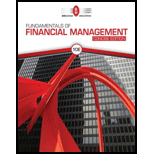
Concept explainers
a.
To identify: The effect on yield curve immediately after the announcement of the new congress administration.
Introduction:
Yield: Yield is the percentage of securities at which the return is provided by the company to its investors. Yield can be there in the form of dividend and interest.
Steeper Yield Curve: A curve which has shown the expected increment in the interest rates due to inflation is known as steeper yield curve.
b.
To identify: The effect on yield curve if the Congress and administration exists for two or three years in future.
Introduction:
Yield: Yield is the percentage of securities at which the return is provided by the company to its investors. Yield can be there in the form of dividend and interest.
Steeper Yield Curve: A curve which has shown the expected increment in the interest rates due to inflation is known as steeper yield curve.
Trending nowThis is a popular solution!

Chapter 6 Solutions
Fundamentals Of Financial Management, Concise Edition (mindtap Course List)
